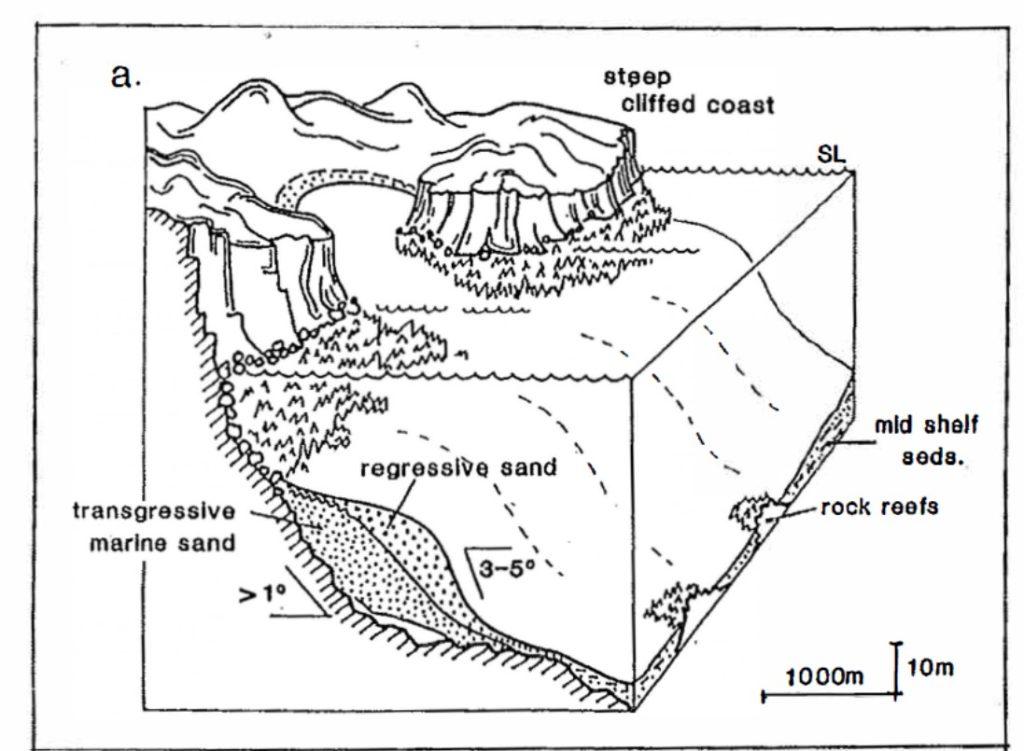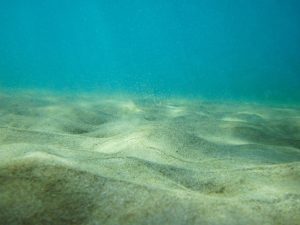Sydney Shelf Sand Bodies: from Discovery to Metromix
In 1984 a paper appeared in an international journal describing the existence of elongate, shore-parallel sand bodies on the lower shoreface in water depths greater than 30m off the Sydney cliffed coastline. The paper was the joint effort of Mike Field and Peter Roy (Journal of Sedimentary Petrology, vol. 54, 1292-1302). Mike worked in the US Geological Survey and had visited Peter at the NSW Geological Survey on sabbatical leave. He had undertaken extensive sediment work on the US Atlantic continental shelf. Together they saw the importance of reporting in the international literature the distinctive characteristics of these little-known features: typically convex in profile, comprised of sediment up to 30m thick and with an alongshore extent of tens of kilometres. This blog aims to place in context the passage of discovery of these shelf sand bodies (SSB), through the research phase on their character and origin, to their exploration and assessment as a resource.
The story behind the discovery and recognition of the significance of the Sydney SSB is multifaceted. It could be said to start with exploratory work on the continental shelf by Charlie Phipps of Sydney University in the 1960s. Along with his colleague J. Shirley they studied shelf topography and sediment types. Phipps published very little but Shirley wrote up his results in Journal Geological Society of Australia (1964, vol. 11, 331-341). Charlie was quite an entrepreneur and through Sydney University acquired access to a survey boat (the “Matthew Flinders”) and later a submersible (see John Hudson, 2020 in Journal of Coastal Research (Issue 101, p. 183-187). During the early 1970s, Charlie was engaged by the Sydney Water Board to run seismic lines off the sewer outfalls that then were discharging from the base of the cliff face at North Head, Bondi and Malabar. An undergraduate student of Charlie’s at the time, Ron Boyd, tells us of his travails on the Flinders running seismic lines off Bondi in 1973 where they encountered a convex lobe of sand extending from the base of the cliffs.
The next part of the story saw the confluence of interests of the NSW Geological Survey involving Peter Roy and the Coastal Investigations Section of the Public Works Department led by Angus Gordon (see A. Gordon, in Journal of Coastal Research, 2020, Issue 101, p. 116-122 for details). This work essentially commenced in late 1979 and saw the two agencies undertake programs of seabed mapping and sediment sampling that were critical to the development of deepwater sewer outfalls by what is now Sydney Water and the investigation of potential sand sources for the Sydney construction industry (and possible nourishment of beaches). These studies continued for most of the 1980s into the early 1990s.

I have had the pleasure of working with Peter Roy on many studies. In 1979 we tried to bring together our understanding of the evolution of marine and coastal deposits in NSW and southern Queensland. This work was published in the Journal of the Geological Society of Australia in 1981 (Roy and Thom, vol. 28, 471-489). What we thought was a comprehensive review turned out to have one big omission, namely the Sydney SSB or any other headland-linked SSB off the NSW and southern Queensland coast. It was around this time that Peter became more aware of the unpublished discoveries of Charlie Phipps. Too late for our 1981 paper but just right for the arrival of Mike Field and the information from the seabed mapping surveys of PWD (shown and acknowledged in the 1984 Field and Roy paper).
The 80s witnessed an intense field campaign to document the characteristics of the Sydney SSB. PWD provided a number of reports and papers on sediment processes and features including detailed mapping of rock reefs and sand deposits. Peter’s team was more focused on the SSB. All together they established a data base comprising: 300 km of high resolution seismic off Bondi, Malabar and North Head; regional seismic, sidescan and surface sediment sampling observations of the seabed for the entire Sydney coast; seabed subsurface sediment sampling from 124 vibrocores up to 6m long in water depths from 18-87m (P. Roy, p.comm); and (the analysis of 126 core samples of biogenic carbonate for radiocarbon dating. This is one of the most intensely studied sections of continental shelf in Australia, if not the world (see Roy et al. 1994, in Carter and Woodroffe eds., Coastal Evolution, p. 121-186).
Peter Roy provided the leadership for a team based in the Geography Department of Sydney University on a project called the Sydney Sediment Study (SSS). This project stimulated the careers of Peter Cowell, Marie Ferland and John Hudson. Peter generated the “Shoreface Translation Model” (STM) from this project (see Cowell et al. 1992 in Mathematics and Computers in Simulations, vol, 33, 603-608). In 1990, Marie completed a PhD under Peter Roy’s supervision entitled “Shelf Sand Bodies in South Eastern Australia”, an incredible comprehensive analysis of these features. John undertook much of the sedimentology analyses and field support fundamental to the success of the SSS project (J. Hudson, 2020, Journal of Coastal Research, Issue 101, 183-187).
These projects all showed that the inner continental shelf off Sydney possessed enormous quantities of sand in SSB. A growing city demands sand and quite quickly commercial interests saw potential for using present day dredging technologies to help supply the market. Concerns were expressed by community groups and others on possible adverse impacts of any dredging on Sydney’s beaches such as Bondi and Maroubra. This issue was directly addressed in the PWD and Geological Survey studies. A major environmental impact study was undertaken by a company called Metromix in their proposal to extract sand from the surface of SSB. It was quite comprehensive and in later years has been used for teaching purposes as a model environmental impact statement. The then Coalition Government set up a formal Commission of Inquiry to assess this offshore marine sand aggregate proposal targeting licensed sites on the southern Sydney inner shelf off Cape Banks and Providential Head. Quite abruptly, just as the Inquiry was getting underway, the then Minister for Planning stopped the process in 1994. This led to a position from successive NSW Governments opposed to offshore sand mining. Metromix may still hold licenses over these sites but no extraction for aggregate is currently possible. However, interest in these sands serving as a store or bank for future beach nourishment remains under consideration.
Bruce Thom
Words by Prof Bruce Thom. Please respect the author’s thoughts and reference appropriately: (c) ACS, 2023. For correspondence about this blog post please email admin@australiancoastalsociety.org.au
#247

